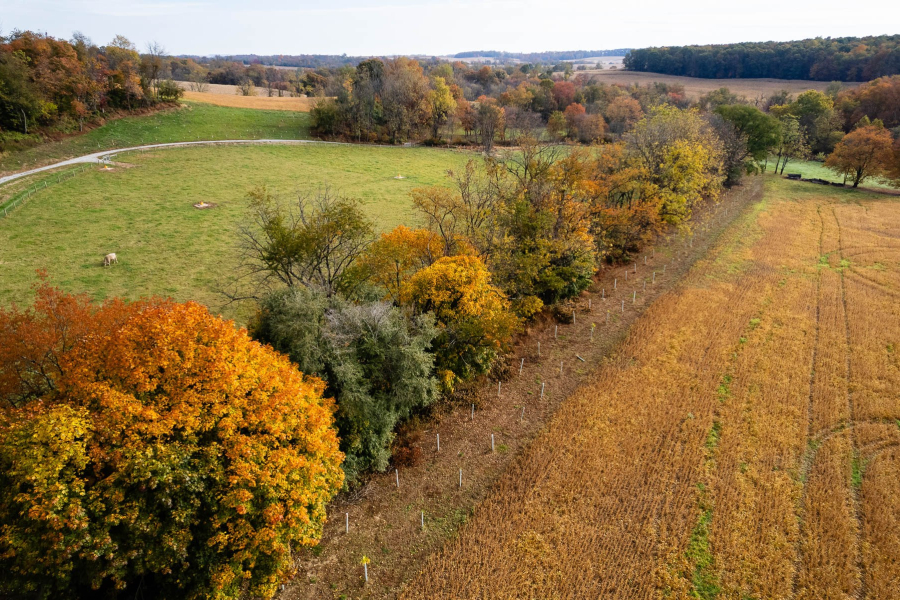Why conserving existing forest buffers is just as important as planting new ones
Chesapeake Bay Program announces progress toward Forest Buffer Outcome

Trees growing alongside streams and rivers, known as forest buffers, are critical to the health of the Chesapeake Bay and its wildlife. That’s why in 2014 when the Chesapeake Bay Watershed Agreement was signed, partners set an ambitious goal of restoring 900 miles of forest buffers each year across the region.
In 2023, Chesapeake Bay Program partners restored 640.5 miles of forest buffers, which is the highest number of new forest buffers restored since 2016. Each jurisdiction of the watershed chipped in, including 298 miles of forest buffers restored in Virginia, 268 miles restored in Pennsylvania, 40 miles restored in Maryland, 21 miles restored in New York, 13 miles restored in West Virginia, and less than one mile restored in Delaware.
Katherine Brownson, who serves as the U.S. Forest Service liaison to the Chesapeake Bay Program and coordinator of the partnership’s Forestry Workgroup, attributes the high number of forest buffer miles restored in 2023 to an increase in state and federal investment, as well as new flexible funding programs.
Landowners can be hesitant to have forest buffers planted on their property because of associated cost, time and maintenance. In some cases, farmers who plant buffers at the edge of their property can no longer use that space for planting crops or grazing animals. To incentivize the planting of buffers, partners have updated their programs to award funds on a rolling basis (rather than an annual), provide funding more quickly, include support for maintenance, limit or eliminate out-of-pocket costs and make the funds available to a wider range of landowners.
This is in addition to the existing Conservation Reserve Enhancement Program, a a U.S. Department of Agriculture program that financially compensates farmers for removing environmentally sensitive land from production and establishing forest buffers.
The Infrastructure Investment and Jobs Act and Inflation Reduction Act have helped advance progress toward forest buffer restoration. Since 2022, the Environmental Protection Agency (EPA) Chesapeake Bay Program Office has increased funding for competitive and jurisdictional grants, providing over $12.6 million in funding for the restoration of forest buffers under the Infrastructure Investment and Jobs Act. Some examples include:
- The Pennsylvania Department of Conservation and Natural Resources received $3 million to enhance their riparian buffer program.
- The New York Department of Environmental Conservation received $2 million to implement a comprehensive riparian forest buffer program.
- The Delaware Department of Natural Resources and Environmental Control received $472,000 to implement their riparian buffer strategy and create a buffer incentive program for private landowners.
The U.S. Forest Service is using $103 million from the Inflation Reduction Act to support urban forestry projects throughout the Chesapeake Bay watershed, with some of the funding going to support forest buffer restoration in communities.
Bay states have also ramped up funding and training for forest buffer restoration, allowing them to work toward their own goals. “Pennsylvania has been hard at work increasing funding and technical assistance with new staff and partner investments in planting streamside forest buffers, and our numbers of acres of streamside forests continue to grow,” says Secretary Cindy Adams Dunn, secretary of Pennsylvania’s Department of Conservation and Natural Resources.
But while forest buffer planting may be gaining momentum, the watershed has lost more forest buffers than it’s gained as of data collected in 2017/2018. The Chesapeake Bay Program’s Land Use/Land Cover data uses satellite imagery to capture changes to the land every four years. Comparing data from 2013/2014 to 2017/2018 showed a net loss of over 21,000 acres of forest buffers. Data for 2021/2022 is expected to be released in fall 2024, but the number of forest buffers planted in the past several years is not enough to make up for the losses.
Forest loss typically occurs to make room for housing, roads, parking lots, data centers and other development. To learn more about tree cover in your area, take a look at the Tree Cover and Status Change factsheets, which are available for every county in the Bay watershed, and the State of Chesapeake Forests Storymap.

Comments
The lead here is this line: "But while forest buffer planting may be gaining momentum, the watershed has lost more forest buffers than its gained as of data collected in 2017/2018." It is so important that we work to have voluntary permanent buffer protection programs available to those who want to incentivize permanent riparian buffer protection. That way we can make sure that these gains from all of these recent programs and plantings are durable and make lasting impact in the long term.
Thank you!
Your comment has been received. Before it can be published, the comment will be reviewed by our team to ensure it adheres with our rules of engagement.
Back to recent stories